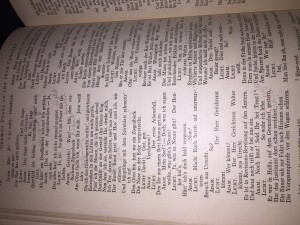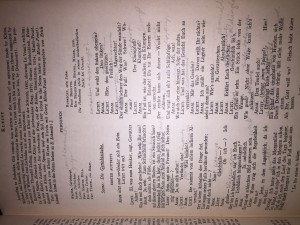When I first entered the library, I had certain kinds of books in mind when I entered the library that I wanted to begin my search in. As soon as we got into the library I decided to enter the first stack I saw just to get a feel for what kind of books I would have the best luck with. I opened book after book that appeared to be rebound. I figured the ones with the most use were the ones that were rebound and therefore I would have luck finding marginalia. I got lost in the books, I lost track of time. I was thinking about how so many other people have touched these books for so many different reasons. I felt like I was entering another world. I must have opened over 50 books, even after I found a promising lead with marginalia that appeared to be from the 19th century. There was so much writing in this book, I could tell the person reading it had poured through the pages, looking for meaning in each word. The book I found contained plays from the 19th Century, all written in German. The author was Thomas Moody Campbell. According to the Chicago Tribune, he taught at a Florida State University for 30 years. He passed away of a heart attack at the age of 57. The book was dedicated to his Wife, Annie Pauline Von Klemmen. All of the marginalia I found is written in German, so there isn’t much I can say about the words themselves. I found marginalia on many of the pages, but the ones with the most writing were on pages in the 70’s. The marginalia is found on so many of the pages and even if there are no words on some pages, the owner often underlined and circled things.



